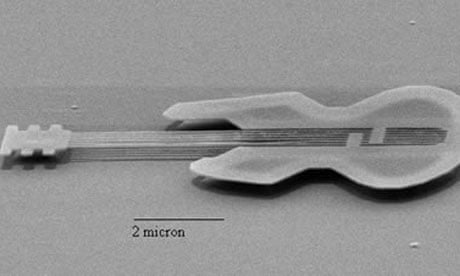What is it? The world's smallest ever music instrument. A miniature guitar made out of crystalline silicon, 10 microns long (about the size of a human red blood cell), with six strings that are each about 100 atoms wide.
How does it work? Though the first nano guitar was created in 1997 at Cornell University, it wasn't until a second model was crafted in 2003 that the instrument was actually "played". No, they didn't make the world's tiniest plectrum and shrink Dennis Quaid down to subatomic size to strum the dainty axe. Because they're so incredibly teeny, the strings could only be sounded by targeting them with miniature lasers in an atomic force microscope. This resulted in the world's smallest ever kerrang! A 40 megahertz signal that is 130,000 times higher than the sound of a full-scale guitar – and reportedly one of the highest-pitched tones recorded.
Where does it come from? Cornell researcher Dustin W Carr created the nano guitar under the direction of Professor Harold G Craighead. The project was intended to be a fun, media-friendly way of advertising nanotechnology. Though there is neither great musical potential or demand for a tiny, silicon guitar that is inaudible to the human ear, the point was to illustrate how incredibly precise and detailed nanotechnology – the science of making molecular-proportioned, functional electromechanical devices – had become. Dr Craighead and his team went on to create even smaller machines – such as nanoscales that can measure the weight of individual bacteria, recording data and diagnosing medical conditions at an atomic level.
Why is it classic? It's just an extremely cool idea. Nanotechnology is often spoken about in cryptic, fearful, science-fiction terms, and it's true that the technology has been used to create surveillance cameras and listening devices smaller than a grain of sand, but the nano guitar is a pure, lighthearted symbol of scientific optimism.
Five facts and things
As the nano guitar is outside the range of even the most sensitive microphone, the acoustic trace of the sound is measured by a computer calculating the reflections of the laser light used to "strum" the strings.
One of the discoveries that came directly out of the nano guitar was the realisation that using electric-driven nanostructures to individually modulate the intensity of tiny laser beams could be useful in fibre optic communications.
If the nano guitar played the highest-pitched note in the universe, what is the lowest? In 2003, x-ray telescopes monitored a black hole in the Perseus galaxy belching out tones that were 57 octaves below human hearing – supposedly the deepest note ever detected.
Still having trouble getting your head around the dimensions of the nano guitar? A nanometre is one-billionth of a metre. A human hair is about 200,000 nanometres in diameter. The nano guitar is just 10,000 nanometres long – one-twentieth the diameter of one of your hairs.

Comments (…)
Sign in or create your Guardian account to join the discussion